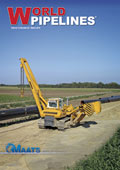Editorial comment
Nord Stream, South Stream: let’s look for a minute at the driving forces behind these gas pipeline projects. European demand for gas is weakened at the moment; the abundance of US shale gas and Middle Eastern LNG makes for what is effectively a gas glut; prices have been driven down and Russian export capacity now exceeds the availability of gas it has to export. Does this initial picture look at all conducive to new gas pipelines?
Register for free »
Get started now for absolutely FREE, no credit card required.
Of course, we can qualify these points one by one. European gas consumption is expected to grow steadily, as gas becomes the evermore-popular fuel of choice; as EU gas production declines; as more gas-fired power stations are commissioned than coal-fired ones; and as continued policies to cut carbon dioxide emissions make gas an attractive choice for countries trying to meet their environmental targets. In addition, long-term Russian gas commitments can offer more energy security in comparison to LNG supplies. Importantly, Russia is building pipelines not to increase export capacity, but rather to diversify its available export routes and lessen its reliance on shipping via transit countries. It’s not simply a matter of volume, it’s the additional supply routes that are the key.
Gazprom’s strategic decision to pursue alternative routes for supplying gas to Europe means that it ensures for itself greater long-term control over exports to the EU, and more negotiating power for the future, although of course it will still need to use transit countries such as Ukraine for some exports.
The theory is that any new pipeline infrastructure from Russia means energy relations with its neighbours will become more civilised: competing routes should force both buyer and seller to put market interests first and politics second. Russia’s well-documented flare-ups with Ukraine, and its other former Soviet-bloc neighbours, should improve given the increased flexibility, and therefore competition, inherent in additional supply routes flowing from east to west.
For its part, the European Commission recently approved financing for a raft of gas and electricity interconnection projects, worth E2.3 billion, as part of a bigger energy security ‘recovery package’ in response to economic and gas-related crises.
New gas projects will help EU member states be prepared should another energy cut-off happen, as has been inflicted by Russia in previous years. Bulgaria suffered last year when Russia turned off the tap and it was unable to receive any gas from its neighbours in Romania and Greece. As part of the EU package, pipelines linking Bulgaria to these two countries will be financed with E45 and E9 million respectively. Other funding will go towards boosting energy infrastructure in the Baltic States. In addition, some E200 million goes to the Nabucco pipeline project, which is aimed at reducing Europe’s dependence on Russian gas by bringing Caspian gas directly to the EU via Turkey. Nabucco would provide another supply route for gas and, critically, another gas supplier.
A multitude of gas connections are being forged in the race to ensure stability for future transport of gas. Each is a strategic move on the part of a country or group of countries, but each is also a leap into a new relationship, in which the supplier and the recipient are committed to making it work. As Ben Aris so nicely puts it in a recent report for the Daily Telegraph (UK), “pipelines are intensely political beasts when they are in the planning stage; but once constructed they are the geo-political equivalent of a marriage”.1 Honey, should we have signed a pre-nup?
1. Ben Aris, The Daily Telegraph, 23rd February 2010.


